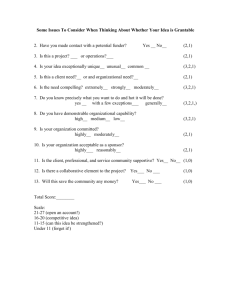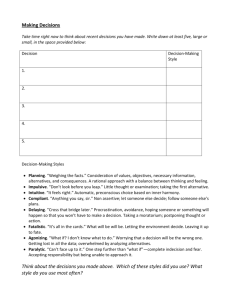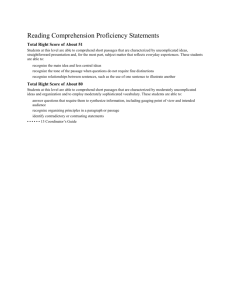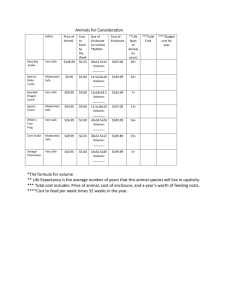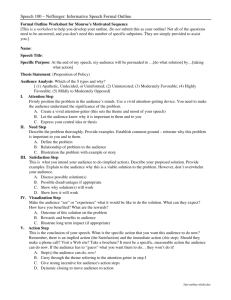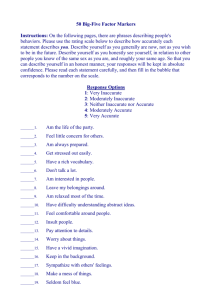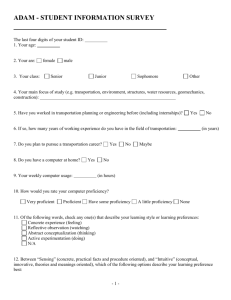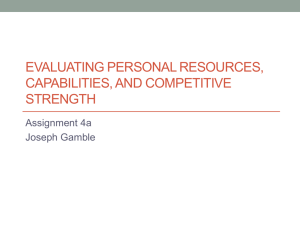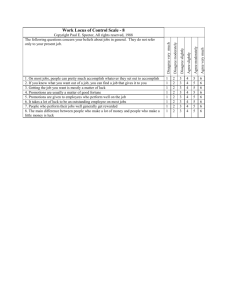General Education Senior Level Assessment Report February 10, 2009
advertisement
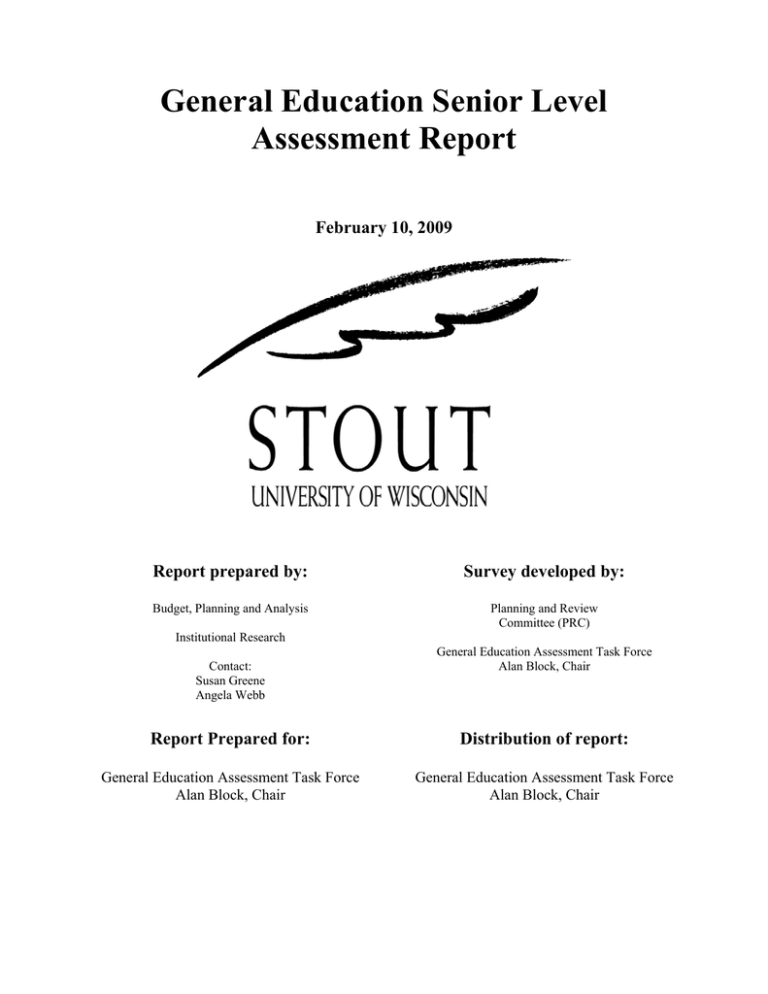
General Education Senior Level Assessment Report February 10, 2009 Report prepared by: Survey developed by: Budget, Planning and Analysis Planning and Review Committee (PRC) Institutional Research Contact: Susan Greene Angela Webb General Education Assessment Task Force Alan Block, Chair Report Prepared for: Distribution of report: General Education Assessment Task Force Alan Block, Chair General Education Assessment Task Force Alan Block, Chair General Education Senior Level Assessment Executive Summary The following is a summary of the main findings from the fall 2008 General Education Senior Level Assessment survey. A new survey instrument was used for fall 2008, so no direct comparisons are made to the results of the previous eleven years. The senior students who completed this survey are the fourth cohort group who received laptop computers as part of the e-scholar program. The survey was completed by 202 senior students, for a response rate of 32%. The authors believe the data support the following general conclusions: The survey was divided into nine General Education course categories of writing effectively, speaking effectively, listening effectively, analytic reasoning, health and physical education, humanities and arts, social and behavioral science, natural science, and technology. Average category ratings ranged from 3.15 to 3.52. • The course category with the highest grand average was technology. • The course category with the lowest grand average was health and physical education. The average ratings on all questions were above 3.0 on a 5-point scale. The range from lowest to highest average ratings was 3.02 to 3.60. • The question with the highest average rating was “understand ways in which technology impacts individuals, society and the future”. • The question with the lowest average rating was “develop a critically examined value system”. Each of the course categories consisted of one or more questions. The highest and lowest rated questions for each of the six categories with at least four questions were • Write effectively: being able to organize ideas was rated highest (3.51) and being able to write complex sentences was rated lowest (3.14). • Speak or present ideas effectively: presenting ideas in organized manner was rated highest (3.51) and recognizing different techniques of conversation was lowest (3.25). • Analytic reasoning: being able to use a sequence of steps in problem solving was rated highest (3.44) and breaking down an argument was lowest (3.19). • Humanities and Arts: highest rated was appreciating history to understand current problems (3.35) and the lowest rated was developing a value system (3.02). • Social and Behavior Sciences: understanding the values of a multicultural world was highest rated (3.45) and understanding effects of politics was lowest rated (3.17). • Technology: understanding the impact of technology was highest rated (3.60) and understanding how technology relates to other disciplines was lowest rated (3.44). 1 General Education Senior Level Assessment Full Report OVERVIEW This report focuses on the results from the fall 2008 General Education Senior Level Assessment (GESLA) survey. A new survey instrument was introduced in 2008, so no direct comparisons are made to previous years. The new survey instrument contained questions for each of the nine general education course categories of writing effectively, speaking effectively, listening effectively, analytic reasoning, health and physical education, humanities and arts, social and behavioral science, natural science, and technology. There were a total of 42 questions. The senior students who completed this survey are the fourth cohort group who received laptop computers (during freshmen orientation) as part of the e-scholar program. METHOD The survey was revised in 2008 to better capture the impact of General Education courses on student learning. The survey revised by Alan Block, chair of the General Education Task Force, with assistance from BPA office. The survey can be found in Appendix A. Prior to sending the survey to the students, a pre-survey notification email was sent to all deans, associate deans, program directors, and department chairs with a copy of the survey and the link to previous GESLA reports. The survey was sent to a 50% random sample of UW-Stout students that were seniors with at least 90 credits earned at UWStout by the beginning of the fall 2008 semester.1 The survey was administered online using Vovici as the survey tool. A variety of methods was used to promote a high response rate. Students in the random sample were sent a pre-survey email notification from the Provost’s office in the week prior to the survey deployment, and several reminder emails were sent to students that had not yet completed the survey. The survey was made available to the 638 senior students from October 10 to December 12. The survey was completed by 202 senior students, for a response rate of 32%. RESULTS Survey results are presented in the next two sections. The first section has a summary of the nine general education course categories results as well as a summary of the highest and lowest rated questions. The second section provides a summary of the specific questions asked for each of the nine categories. 1 Of the total population, 61% began as new freshmen at UW-Stout and 39% were transfer students. Of the transfer students, 33% transferred in as a freshman. 2 Overall Results The survey consisted of the nine General Education course categories of writing effectively, speaking effectively, listening effectively, analytic reasoning, health and physical education, humanities and arts, social and behavioral science, natural science, and technology. Each question in the course category asked student respondents to rate “my general education course-work improved my ability to…” using a five-point scale, where 1 indicated no effect and 5 indicated a strong effect. Each category was comprised of a group of one or more category-specific questions, which were then averaged together to create the category grand averages. 2 The average ratings for each General Education course category are displayed in Figure 1. All of the categories had average scores above 3.0 on a 5-point scale, and the difference between the highest and the lowest average scores was 0.37 points. The technology category had the highest average rating (3.52), followed by the natural sciences (3.47). The two lowest averages were for health and physical education (3.15), and humanities and arts (3.21). Figure 1 Category Averages Technology 3.52 Natural Sciences 3.47 Speak Present Ideas Effectively 3.37 Write Effectively 3.31 Social and Behavioral Sciences 3.31 Listen Effectively 3.28 Analytic Reasoning 3.27 Humanities and the Arts 3.21 Health and Physical Education 3.15 1 2 3 4 5 1=lowest possible rating 5=highest possible rating 2 Statistical analysis was conducted prior to creating the averages to determine if the category averages would be meaningful. The results, included in Appendix B, indicated that it was statistically acceptable to group the individual questions into a category grand average. 3 Table 1 lists the top 15% rated questions and bottom 15% rated questions. Three of the top seven questions were related to technology. Students had the highest average ratings for “understand ways in which technology impacts individuals, society and the future” followed by “understand the implications of technological change”. The lowest rated question was “develop a critically examined value system”. Other lower rated questions were “write complex sentences” and “maintain a sense of physical well-being”. Table 1 Highest rated questions Understand ways technology impacts individuals, society and the future Understand the implications of technological change Present ideas in an organized manner Organize ideas clearly and provide detailed explanation To reason and to explain reasons Understand how technological systems are designed to meet human needs and wants Understand sciences affect daily life Lowest rated questions Develop a critically examined value system Write complex sentences Maintain a sense of physical well-being Recognize significance of the arts Understand effect of political ideas and systems Maintain a sense of mental well-being Average 3.60 3.55 3.51 3.51 3.49 3.47 3.47 Average 3.02 3.14 3.14 3.17 3.17 3.17 Category Specific Results The next section summarizes the results for each question in the nine categories. Write Effectively Figure 2 All of the averages for writing effectively were above 3.1. Figure 2 shows student respondents rated “organize ideas clearly and provide detailed examples” highest, followed by “to reason and explain reasons”. The lowest rated question was “write complex sentences”. Frequency of response for each question is listed in Table 2. 4 Speak or Present Ideas Effectively The averages for speaking or presenting ideas effectively were 3.25 or higher as shown in Figure 3. Student respondents rated the question “present ideas in an organized manner” the highest with an average of 3.51. The lowest average was for “recognize and participate in techniques of conversation” where the average was 3.25. Note that the difference between the highest and lowest averages was 0.26 points on a 5-point scale. Frequency response to each question is listed in Table 2. Figure 3 Listen Effectively The two questions in this category had average ratings above 3.0. “Evaluate arguments” had an average of 3.36 and “follow the argument and identify persuasive techniques employed” had an average rating of 3.20. 5 Analytic Reasoning The average ratings for analytic reasoning were all higher than 3.15. Student respondents rated the question “carry out a sequence of logically connected steps to solve a problem” the highest with an average of 3.44, followed by “evaluate arguments” with an average rating of 3.36. The lowest rated question with an average of 3.19 was “break an argument down into component parts”. The frequency of responses for each question is listed in Table 2. Figure 4 ANALYTIC REASONING My general education course‐work improved my ability to ... 3.44 Carry out sequence of logically connected steps to solve a problem Evaluate arguments 3.36 3.31 Understands importance of data in projections Appropriately relating sample to population 3.28 Make a logical argument 3.28 Follow a logical argument 3.27 3.25 Create an argument from a variety of sources 3.21 Appropriately connect analytical thinking in support of intuition 1 Appreciate importance quantitative methods in decision making 3.20 Follow the argument and identify persuasive techniques employed 3.20 Break an argument down into component parts 3.19 2 3 4 5 Rating Scale: 1=None ... 5=Strong Health and Physical Education The health and physical education category had two questions. As noted in Figure 1, health and physical education had the lowest overall category average of 3.15. The first question asked the respondents “improved my ability to maintain a sense of physical well-being”, and had an average of 3.14.The second question, “improved my ability to maintain a sense of mental well-being”, had an average of 3.17. The frequency of responses for each question is listed in Table 2. 6 Humanities and the Arts Figure 5 The average ratings for the humanity and arts questions were all higher than 3.0. The highest average rating was for the question “appreciate the value of history in understanding current problems” with an average of 3.35. The lowest rated question for this category was “develop a critically examined value system” with an average of 3.02. The frequency distribution is located in Table 2. Social and Behavioral Sciences Figure 6 Student respondents rated the question “understand the values, ideas, and heritages of a multicultural world” the highest in the social and behavioral sciences category with an average of 3.45. The lowest question from this category was “understand the effect of political ideas and systems” with an average of 3.17. The frequency distribution for the social and behavioral sciences questions are shown in Table 2. Natural Sciences The natural sciences category question, “my general education course-work improved my ability to understand how the natural and physical sciences affect daily life and how daily life affects the natural and physical sciences”, was in the top 15% of all questions and had an average rating of 3.47. 7 Technology Figure 7 shows that all of the technology questions had average ratings above 3.4. The question with the highest average rating was “understand ways in which technology impacts individuals, society and the future”. The question with the lowest rating was “understand how technology relates to other subjects and/or disciplines”. The frequency distribution for each respondent is shown in Table 2. Figure 7 8 Table 2 Total Number of Responses (Percent of Total) Question None Slightly Moderately Considerably Strong Understand and use appropriate grammar 5 (2.5%) 40 (19.8%) 66 (32.7%) 68 (33.7%) 23 (11.4%) Organize ideas clearly and provide detailed explanation and examples 3 (1.5%) 28 (13.9%) 61 (30.2%) 82 (40.6%) 27 (13.4%) To reason and to explain reasons Use a variety of sentences Write complex sentences Employ precise vocabulary Write creatively Write with originality Present ideas in an organized manner Present ideas in a reasoned manner Present ideas in a convincing manner Present ideas in a creative manner Use language and persuasive techniques appropriate to the situation Recognize and participate in techniques of conversation Critically examine and explain reasons Follow the argument and identify persuasive techniques employed Evaluate arguments 7 (3.5%) 10 (5%) 10 (5%) 12 (5.9%) 12 (5.9%) 9 (4.5%) 2 (1%) 3 (1.5%) 5 (2.5%) 10 (5%) 5 (2.5%) 8 (4%) 7 (3.5%) 7 (3.5%) 7 (3.5%) 26 (12.9%) 38 (18.8%) 44 (21.8%) 37 (18.3%) 38 (18.8%) 36 (17.8%) 27 (13.4%) 28 (13.9%) 30 (14.9%) 32 (15.8%) 39 (19.3%) 37 (18.3%) 31 (15.3%) 49 (24.3%) 30 (14.9%) 64 (31.7%) 67 (33.2%) 75 (37.1%) 63 (31.2%) 68 (33.7%) 74 (36.6%) 69 (34.2%) 79 (39.1%) 66 (32.7%) 65 (32.2%) 74 (36.6%) 74 (36.6%) 81 (40.1%) 61 (30.2%) 73 (36.1%) 71 (35.1%) 61 (30.2%) 51 (25.2%) 67 (33.2%) 53 (26.2%) 56 (27.7%) 73 (36.1%) 67 (33.2%) 72 (35.6%) 68 (33.7%) 55 (27.2%) 60 (29.7%) 57 (28.2%) 65 (32.2%) 65 (32.2%) 34 (16.8%) 26 (12.9%) 21 (10.4%) 20 (9.9%) 30 (14.9%) 25 (12.4%) 31 (15.3%) 24 (11.9%) 28 (13.9%) 27 (13.4%) 26 (12.9%) 22 (10.9%) 25 (12.4%) 19 (9.4%) 25 (12.4%) 6 (3%) 35 (17.3%) 79 (39.1%) 63 (31.2%) 19 (9.4%) 4 (2%) 4 (2%) 10 (5%) 9 (4.5%) 9 (4.5%) 39 (19.3%) 30 (14.9%) 37 (18.3%) 39 (19.3%) 29 (14.4%) 73 (36.1%) 70 (34.7%) 75 (37.1%) 70 (34.7%) 76 (37.6%) 67 (33.2%) 69 (34.2%) 60 (29.7%) 64 (31.7%) 57 (28.2%) 18 (8.9%) 29 (14.4%) 19 (9.4%) 17 (8.4%) 25 (12.4%) 8 (4%) 36 (17.8%) 67 (33.2%) 68 (33.7%) 20 (9.9%) 9 (4.5%) 7 (3.5%) 39 (19.3%) 38 (18.8%) 85 (42.1%) 75 (37.1%) 40 (19.8%) 57 (28.2%) 27 (13.4%) 22 (10.9%) Maintain a sense of physical well-being 31 (15.3%) 28 (13.9%) 60 (29.7%) 45 (22.3%) 37 (18.3%) Maintain a sense of mental well-being Develop a critically examined value system 23 (11.4%) 19 (9.4%) 37 (18.3%) 44 (21.8%) 55 (27.2%) 67 (33.2%) 54 (26.7%) 50 (24.8%) 31 (15.3%) 18 (8.9%) Understand the ethical consequences of decisions 11 (5.4%) 30 (14.9%) 84 (41.6%) 49 (24.3%) 26 (12.9%) Understand the value of literature in expressing ideas Recognize and understand the significance of the fine and performing arts to a culture Appreciate the value of history in understanding current problems Understand the values, ideas, and heritages of a multicultural world Understand the effect of political ideas and systems Understand the effects of social forces on individual, groups and institutions Understand the effects of economic forces on individual, groups and institutions Understand how the natural and physical sciences affect daily life and how daily life affects the natural and physical sciences Understand how technology relates to other subjects and/or disciplines Understand how technological systems are designed to meet human needs and wants 13 (6.4%) 40 (19.8%) 64 (31.7%) 57 (28.2%) 25 (12.4%) 15 (7.4%) 44 (21.8%) 62 (30.7%) 46 (22.8%) 31 (15.3%) 10 (5%) 5 (2.5%) 7 (3.5%) 35 (17.3%) 35 (17.3%) 48 (23.8%) 63 (31.2%) 57 (28.2%) 76 (37.6%) 56 (27.7%) 67 (33.2%) 38 (18.8%) 34 (16.8%) 34 (16.8%) 29 (14.4%) 3 (1.5%) 40 (19.8%) 75 (37.1%) 53 (26.2%) 28 (13.9%) 7 (3.5%) 36 (17.8%) 74 (36.6%) 57 (28.2%) 25 (12.4%) 5 (2.5%) 32 (15.8%) 64 (31.7%) 59 (29.2%) 38 (18.8%) 5 (2.5%) 32 (15.8%) 64 (31.7%) 67 (33.2%) 31 (15.3%) 7 (3.5%) 24 (11.9%) 69 (34.2%) 64 (31.7%) 34 (16.8%) 4 (2%) 30 (14.9%) 55 (27.2%) 71 (35.1%) 38 (18.8%) 5 (2.5%) 26 (12.9%) 58 (28.7%) 64 (31.7%) 46 (22.8%) Follow a logical argument Make a logical argument Carry out a sequence of logically connected steps to solve a problem Appreciate the importance of quantitative methods in decision making Appropriately connect analytical thinking in support of intuition Understands the importance of data in projections and trends Appropriately relate information obtained from a sample to the population being studied Break an argument down into component parts Create an argument from a variety of sources Understand the implications of technological change Understand ways in which technology impacts individuals, society and the future 9 Appendix A Survey Instrument General Education Senior Level Assessment Please read the following background before answering questions on this survey. General Education is defined as: The General Education Program provides the core of what it means to be a well educated university graduate. The goal is to promote human excellence through a broad foundation of skills and knowledge required to realize a meaningful personal, professional, and civic life. The General Education Program is intended to enable students to contribute to and live responsibly in a diverse, interconnected, and technologically sophisticated global community. Approximately 1/3 of the credits required for a degree at UW-Stout must be in General Education. You have taken approximately 40 to 46 general education credits. The following list depicts typical general education categories and examples of courses in those categories. Communication Skills Communication Skills are the study and application of expressive and receptive language skills, most often exercised in reading, writing, speaking, and listening. These fundamental skills are basic to human development and academic functioning. Courses: Freshman English Composition; Fundamentals of Speech Analytic Reasoning Analytic reasoning is the formulation and critique of deductive and inductive arguments, both quantitative and non-quantitative. This reasoning is essential to many intellectual activities, such as critical thinking, problem-solving, creating and applying. This component requires students to engage in general learning experiences in mathematics, logic, statistics, or computer science. Courses: Elementary Statistics; Calculus I; College Math I and II Health and Physical Educ. Health enhancement is the study of physical and mental well-being. Courses: Physical Activity Courses; Nutrition for Healthy Living; Lifespan Sexuality Humanities and the Arts 10 The Humanities investigate human constructs and values, as opposed to those studies that investigate natural and physical processes and those that are concerned with the development of basic or professional skills. The humanistic disciplines--such as art history, history, music appreciation, literature, and philosophy--are concerned with questions, issues and concepts basic to the formation of character and the establishment of values in a human context; they induce an organic study of letters and knowledge; they provide literary, aesthetic and intellectual experiences which enrich and enlighten human life. Courses: American Literature; Western Civilization; Modern World Arts employ conscious use of skill and creative imagination in the production of artistic objects or performances which stress values that stand outside conventional ideas of utility. Courses: Drawing Social & Behavioral Sciences The social sciences formulate and verify general hypotheses regarding human behavior. The social sciences deal with the behavior of societal, economic, political and cultural groups. Consequently this component focuses on the academic disciplines of sociology, economics, political science and cultural anthropology, insofar as these disciplines deal with general and non-applied knowledge concerning social behavior. Courses: Economics I; Cultural Anthropology; American Government The behavioral sciences include general knowledge about the psychological behavior of human beings, insofar as this knowledge concerns the human being's relationships to the self and to other individuals. Criteria focus on the general and non-applied learning experiences in the academic field of psychology. Courses: General Psychology; Lifespan Human Development Natural Sciences with Lab The Natural Sciences are the sciences of the physical world, its phenomena, and the laws governing these phenomena. The branches of Natural Sciences--such as astronomy, geosciences, biological sciences, chemistry, physics--deal primarily with matter, energy, and their interrelations and transformations; with living organisms and vital processes; with the laws and phenomena relating to organisms, plants and animal life; with the physical processes and phenomena of particular systems; and with the physical properties and composition of nature and its products. Courses: Biology; General Chemistry; Physics Technology Technology is the knowledge, volition, and process of utilizing tools, resources, and systems resulting in control over the natural and artificial environment altering the human condition. Courses: Exploring Technology; Communication and Information Technology 11 To review a comprehensive list of General Education Courses, refer to the URL link in your email invitation. Thinking about your general education, please answer the following questions by selecting your response. ________________________________________________________ Communication Skills My general education course-work improved my ability to: Write Effectively 1) Understand and use appropriate grammar None Slightly Moderately Considerably Strong 2) Organize ideas clearly and provide detailed explanation and examples None Slightly Moderately Considerably Strong 3) To reason and to explain reasons None Slightly Moderately Considerably Strong 4) Use a variety of sentences None Slightly Moderately Considerably Strong 12 5) Write complex sentences None Slightly Moderately Considerably Strong 6) Employ precise vocabulary None Slightly Moderately Considerably Strong 7) Write creatively None Slightly Moderately Considerably Strong 8) Write with originality None Slightly Moderately Considerably Strong Speak or Present Ideas Effectively My general education course-work improved my ability to: 9) Present ideas in an organized manner None Slightly Moderately Considerably Strong 10) Present ideas in a reasoned manner None Slightly Moderately Considerably Strong 13 11) Present ideas in a convincing manner None Slightly Moderately Considerably Strong 12) Present ideas in a creative manner None Slightly Moderately Considerably Strong 13) Use language and persuasive techniques appropriate to the situation None Slightly Moderately Considerably Strong 14) Recognize and participate in techniques of conversation None Slightly Moderately Considerably Strong 15) Critically examine and explain reasons None Slightly Moderately Considerably Strong Listen Effectively My general education course-work improved my ability to: 16) Follow the argument and identify persuasive techniques employed None Slightly Moderately Considerably Strong 14 17) Evaluate arguments None Slightly Moderately Considerably Strong ________________________________________________________ Analytic Reasoning My general education course-work improved my ability to: 18) Follow a logical argument None Slightly Moderately Considerably Strong 19) Make a logical argument None Slightly Moderately Considerably Strong 20) Carry out a sequence of logically connected steps to solve a problem None Slightly Moderately Considerably Strong 21) Appreciate the importance of quantitative methods in decision making None Slightly Moderately Considerably Strong 15 22) Appropriately connect analytical thinking in support of intuition None Slightly Moderately Considerably Strong 23) Understands the importance of data in projections and trends None Slightly Moderately Considerably Strong 24) Appropriately relate information obtained from a sample to the population being studied None Slightly Moderately Considerably Strong 25) Break an argument down into component parts None Slightly Moderately Considerably Strong 26) Create an argument from a variety of sources None Slightly Moderately Considerably Strong ________________________________________________________ 16 Health and Physical Education My general education course-work improved my ability to: 27) Maintain a sense of physical well-being None Slightly Moderately Considerably Strong 28) Maintain a sense of mental well-being None Slightly Moderately Considerably Strong ________________________________________________________ Humanities and the Arts My general education course-work improved my ability to: 29) Develop a critically examined value system None Slightly Moderately Considerably Strong 30) Understand the ethical consequences of decisions None Slightly Moderately Considerably Strong 31) Understand the value of literature in expressing ideas None Slightly Moderately Considerably Strong 17 32) Recognize and understand the significance of the fine and performing arts to a culture None Slightly Moderately Considerably Strong 33) Appreciate the value of history in understanding current problems None Slightly Moderately Considerably Strong ________________________________________________________ Social and Behavioral Sciences 34) Understand the values, ideas, and heritages of a multicultural world None Slightly Moderately Considerably Strong 35) Understand the effect of political ideas and systems None Slightly Moderately Considerably Strong 36) Understand the effects of social forces on individual, groups and institutions None Slightly Moderately Considerably Strong 37) Understand the effects of economic forces on individual, groups and institutions None Slightly Moderately Considerably Strong 18 Natural Sciences My general education course-work improved my ability to: 38) Understand how the natural and physical sciences affect daily life and how daily life affects the natural and physical sciences None Slightly Moderately Considerably Strong Technology 39) Understand how technology relates to other subjects and/or disciplines None Slightly Moderately Considerably Strong 40) Understand how technological systems are designed to meet human needs and wants None Slightly Moderately Considerably Strong 41) Understand the implications of technological change None Slightly Moderately Considerably Strong 42) Understand ways in which technology impacts individuals, society and the future None Slightly Moderately Considerably Strong 19 Appendix B Internal Consistency testing Prior to combining individual questions into the corresponding course category, a statistical test for internal consistency, Chronbach’s alpha, was performed. Alpha measures the extent to which item responses within a category correlate with each other. Alpha can range from 0, indicating no pattern of responses to questions within the category, to 1 indicating a perfect correspondence of responses to questions within the category (i.e. rate every question as a 3). In general, for questions to be grouped together as a scale or category, alpha should be 0.70 or higher. Table B1 shows an alpha value of .90 or higher for each of the proposed categories for the GESLA survey. Therefore, we combined the questions into categories and calculated category grand averages. Table B1 Category Write effectively Speak or present ideas effectively Listen effectively Analytic reasoning Health and physical education Humanities and the arts Social and behavioral sciences Technology Chronbach’s alpha .94 .94 .90 .95 .94 .93 .90 .94 20
